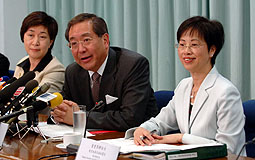 |
More jobs: Secretary for Education & Manpower Professor Arthur Li says more than 1,000 teaching posts will be created to support the "334" academic structure's implementation. |

|
Measures will be taken to enable secondary schools to prepare for a diversified senior secondary curriculum before the "334" academic structure's implementation in 2009, Secretary for Education & Manpower Professor Arthur Li says.
The new curriculum will benefit Secondary One students of the current year and thereafter.
After consulting the education sector and parents' groups, Mr Li spoke to reporters, to describe the measures to be implemented.
These include:
* adopting relaxed criteria for approving classes. Under normal circumstances, 38 students will be allocated to each Seconary One class. For schools with redundant teachers, the basis of 35 students per class will be used for calculating the number of approved classes;
* reducing class size to 24 students on average. For schools using 35 students a class as the basis for calculating the number of approved classes, if they operate three classes they can have as few as 24 students a class;
* maintaining class structure's stability. The approved number of Secondary One and Senior Secondary One classes after the September headcount will be used for approving the Secondary Two and Three classes and Senior Secondary Two and Three classes in the subsequent years for the same cohort of students;
* capping student enrolment per class. Enrolment will be capped at 40 a class to avoid over-enrolment in individual schools which will affect students' learning and enrolment in other schools;
* reviewing class size. The standard class size will be reviewed and adjusted in 2012-13;
* flexible arrangements for teachers' retirement age. To cope with the shortfall in teacher supply in 2011-12, when students of the new and old systems co-exist, the bureau will be flexible about teahers' retirement age, having regard individual cases' merit;
* providing options for schools that operate less than three classes. The options are:
(i) having the school-sponsoring body inject additional resources to ensure there are adequate elective subject choices for senior secondary students;
(ii) merging or collaborating with other schools to provide students with adequate elective subject choices;
(iii) applying for Quality Assurance Special Review;
(iv) operating junior secondary classes based on a "per capita" subvention mode; or
(v) joining the Direct Subsidy Scheme or turning private.
"We believe the schools concerned will be able to pick a suitable option having regard to their actual needs and development plans," Professor Li said.
More teaching posts
"Good teachers need not worry about unemployment. To support the implementation of the new senior secondary structure, we will provide extra resources to create more than 1,000 posts. Moreover, there will be more than 6,000 vacancies arising from natural wastage in the next five years. All in all, we estimate that there will be a shortfall of 1,200 teachers when students of the old and new systems co-exist in 2011-12."
Professor Li pledged a review aimed at adjusting the number of students per class from 2012-13 onwards will be carried out. Assistance will also be offered to individual teachers, including implementing the Sabbatical Leave for Teacher Professional Development Scheme and the Early Retirement Scheme, as well as employing suitable surplus teachers to work in the bureau on curriculum development or to give professional support to schools.
He called on the education sector to put students' interests first. They should join forces to build up the new academic structure and come up with feasible plans, as early as possible, for the provision of a diversified curriculum.
Go To Top
|



